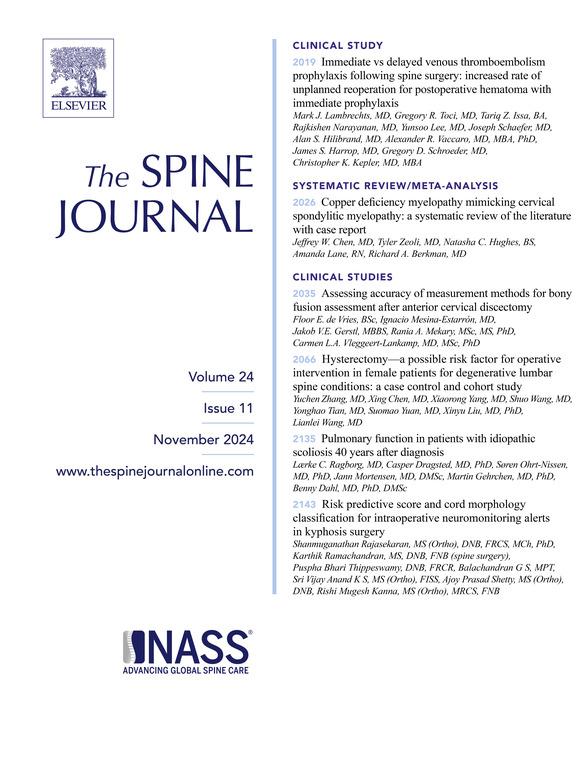92. The anterior intercrest line is a novel accurate surface marking for identifying the L4/5 disc level: a prospective agreement study with fluoroscopy
IF 4.7
1区 医学
Q1 CLINICAL NEUROLOGY
引用次数: 0
Abstract
BACKGROUND CONTEXT
Anterior exposure for lumbar surgery is increasingly used in contemporary spine practice. There have been no previous reports of reliable surface landmarks for determining the optimal incision site for anterior access without fluoroscopy
PURPOSE
To assess the accuracy of the anterior intercrest line for predicting the surface projection of the L4/5 disc level, compared with the fluoroscopically determined level.
STUDY DESIGN/SETTING
A prospective agreement study of consecutive patients undergoing anterior lumbar exposure for either interbody fusion or total disc replacement surgery at L4/5
PATIENT SAMPLE
The study included all patients undergoing primary anterior lumbar disc surgery at our institution from November 2022 to January 2024. Indications for surgery were severe degenerative disc disease, radiculopathy, or Grades 1–2 degenerative or isthmic spondylolisthesis. Exclusion criteria for surgery were disc disease involving ≥ 3 levels, Grades 3–4 spondylolisthesis, significant iliac artery or aortic pathology, morbid obesity (body mass index [BMI] > 35 kg/m2), previous complex/extensive retroperitoneal surgery, or abdominal/pelvic radiotherapy. Exclusion criterion for this study was transitional lumbosacral anatomy. Outcome measures: The primary outcome measure was the distance from the symphysis pubis to the skin markings for the L4/5 level, as determined by the intercrestal line method or fluoroscopic method.
OUTCOME MEASURES
Agreement of anterior inter-crest line for predicting the surface projection of the L4/5 disc level
METHODS
The anterior inter-crest line was denoted by placing a silk tie anteriorly between the bilateral iliac crests palpated in the midaxillary line. The skin was then marked in the abdominal midline along this line. Next, the surface projection of the L4/5 disc was determined using lateral fluoroscopy and marked on the skin in the anterior midline. The distance between the upper palpable margin of the symphysis pubis and each L4/5 skin mark was measured, and the marking modality difference (MMD) was calculated as the difference in distances between the two methods.
RESULTS
A total of 83 patients were assessed for inclusion; two patients were excluded because of transitional anatomy. The mean patient age was 48±13 years (range, 19 to 77 years), and 60% were male (n=49). The MMD between the fluoroscopically determined L4/5 level and the inter-crest line was 0.36±1.19 cm [95% confidence interval (CI), 0.10 to 0.62; range, −2.5 to 5 cm]. The intraclass correlation coefficient between distances determined by the two methods was 0.84 [95% CI, 0.76 to 0.89], demonstrating high agreement between the techniques. Multiple linear regression analyses revealed no significant associations between MMD and age, sex, BMI, or operative position.
CONCLUSIONS
There was high agreement between the anterior inter-crest line method and fluoroscopy for determining the surface projection of the L4/5 disc. The anterior inter-crest line is a simple, clinically accurate, and reliable tool for planning the location of the skin incision for anterior exposure of the L4/5 disc level. Using this line would reduce radiation exposure, overall operative times, and costs.
FDA Device/Drug Status
This abstract does not discuss or include any applicable devices or drugs.
92. 前嵴间线是识别L4/5椎间盘水平的一种新的精确表面标记:一项与透视一致的前瞻性研究
背景:在当代脊柱实践中,腰椎手术的背景暴露越来越多地被使用。在没有透视的情况下,尚无可靠的表面标志来确定最佳前路切口位置的报道。目的:与透视确定的水平相比,评估前嵴间线预测L4/5椎间盘水平表面投影的准确性。研究设计/设置一项前瞻性一致性研究,研究对象为连续接受腰椎前路暴露进行体间融合术或全椎间盘置换术的l4 /5患者。患者样本:该研究包括2022年11月至2024年1月在我院接受原发性前路腰椎间盘手术的所有患者。手术指征为严重退行性椎间盘疾病、神经根病或1-2级退行性或峡部滑脱。排除手术标准为椎间盘病变≥3级、3 - 4级椎体滑脱、显著髂动脉或主动脉病变、病态肥胖(体重指数[BMI] 35 kg/m2)、既往复杂/广泛腹膜后手术或腹部/盆腔放疗。本研究的排除标准是过渡性腰骶解剖。结果测量:主要结果测量是耻骨联合到L4/5节段皮肤标记的距离,由嵴间线法或透视法确定。前嵴间线预测L4/5椎间盘水平面投影的一致性方法前嵴间线通过在腋中线触诊的双侧髂嵴之间放置丝带来表示。然后沿着这条线在腹部中线标记皮肤。接下来,使用侧位透视确定L4/5椎间盘的表面投影,并在前中线的皮肤上标记。测量耻骨联合上可触缘与各L4/5皮肤标记的距离,计算标记模态差(MMD)作为两种方法距离的差值。结果共83例患者纳入tsa评估;2例患者因移行解剖被排除。患者平均年龄48±13岁(19 ~ 77岁),男性占60% (n=49)。透视测定的L4/5水平与嵴间线之间的MMD为0.36±1.19 cm[95%可信区间(CI), 0.10至0.62;范围:−2.5 ~ 5cm]。两种方法确定的距离之间的类内相关系数为0.84 [95% CI, 0.76至0.89],表明两种技术之间的一致性很高。多元线性回归分析显示烟雾病与年龄、性别、BMI或手术体位之间无显著关联。结论前嵴间线法与透视法在确定L4/5椎间盘表面突位上具有较高的一致性。前嵴间线是一种简单、临床准确、可靠的工具,可用于规划L4/5椎间盘水平前暴露的皮肤切口位置。使用这条管线将减少辐射暴露、整体操作时间和成本。FDA器械/药物状态本摘要不讨论或包括任何适用的器械或药物。
本文章由计算机程序翻译,如有差异,请以英文原文为准。
求助全文
约1分钟内获得全文
求助全文
来源期刊

Spine Journal
医学-临床神经学
CiteScore
8.20
自引率
6.70%
发文量
680
审稿时长
13.1 weeks
期刊介绍:
The Spine Journal, the official journal of the North American Spine Society, is an international and multidisciplinary journal that publishes original, peer-reviewed articles on research and treatment related to the spine and spine care, including basic science and clinical investigations. It is a condition of publication that manuscripts submitted to The Spine Journal have not been published, and will not be simultaneously submitted or published elsewhere. The Spine Journal also publishes major reviews of specific topics by acknowledged authorities, technical notes, teaching editorials, and other special features, Letters to the Editor-in-Chief are encouraged.
 求助内容:
求助内容: 应助结果提醒方式:
应助结果提醒方式:


